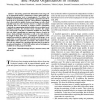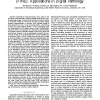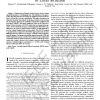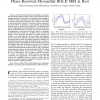159
click to vote
TMI
2016
9 years 9 months ago
2016
— The aim of this study is about tracing filamentary structures in both neuronal and retinal images. It is often crucial to identify single neurons in neuronal networks, or sepa...
146
click to vote
TMI
2016
9 years 9 months ago
2016
Automatic cell segmentation can hardly be flawless due to the complexity of image data particularly when time-lapse experiments last for a long time without biomarkers. To addres...
154
click to vote
TMI
2016
9 years 9 months ago
2016
—Extracting geometrical information from large 2D or 3D biomedical images is important to better understand fundamental phenomena such as morphogenesis. We address the problem of...
171
click to vote
TMI
2016
9 years 9 months ago
2016
—Quantitative histomorphometry (QH) refers to the process of computationally modeling disease appearance on digital pathology images. This proceduretypically involves extraction ...
156
click to vote
TMI
2016
9 years 9 months ago
2016
—Registration of images in the presence of intra-image signal fluctuations is a challenging task. The definition of an appropriate objective function measuring the similarity b...
161
click to vote
TMI
2016
9 years 9 months ago
2016
—A fundamental means for understanding the brain’s organizational structure is to group its spatially disparate regions into functional subnetworks based on their interactions....
153
click to vote
TMI
2016
9 years 9 months ago
2016
—Atherosclerosis and Abdominal Aortic Aneurysms (AAAs) are two common vascular diseases associated with mechanical changes in the arterial wall. Pulse Wave Imaging (PWI), a techn...
180
click to vote
TMI
2016
9 years 9 months ago
2016
Abstract—Cardiac Phase-resolved Blood-Oxygen-Level Dependent (CP–BOLD) MRI provides a unique opportunity to image an ongoing ischemia at rest. However, it requires post-process...
275
click to vote
TMI
2016
9 years 9 months ago
2016
—The accurate segmentation of lung lesions from computed tomography (CT) scans is important for lung cancer research and can offer valuable information for clinical diagnosis and...




